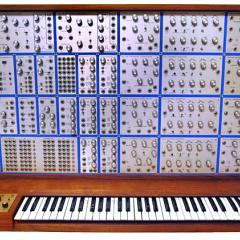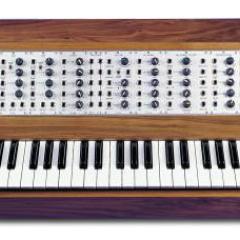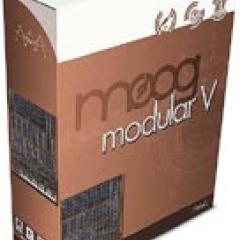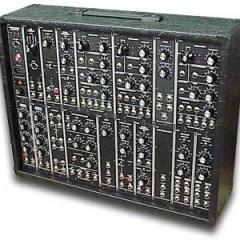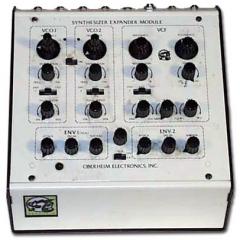Moog Synthesizer 1c/2c/3c

Moog 55
If you were to look up "Vintage Synthesizer" in the dictionary, you would likely find a picture of a Moog modular system. Robert Moog is considered the father of analog synthesizers — not because he was the first to build such instruments, but because his brilliant circuit designs sounded amazing and thus, became the most popular among serious musicians looking to forge new ground in music. The first Moog modular prototype was built in in 1964, with orders for custom systems being taken as early as 1965, and a commercially available product line by 1967. Moog Music continued to build and sell these analog music machines to universities, studios and musicians throughout the sixties and seventies. Eventually, the technology in these systems was transferred into more compact, portable and affordable synthesizers like the Minimoog, ultimately giving rise to the modern synthesizer.
As imposing as these systems may look, they are merely solid walnut cabinets housing smaller dedicated function “modules” which, when interconnected by patch cables, can be used to create, shape and manipulate electronic sounds into musical bliss. This modular approach allowed buyers to configure the systems to meet their needs or their budgets. In addition to custom configurations, Moog Music also offered pre-configured systems in a variety of models:
| Model | Description | Years |
|---|---|---|
| Synthesizer 1c | Limited complexity, designed to satisfy the requirements of independent composers. | 1967-73 |
| Synthesizer 1p | A portable version of the 1c plus space for an optional sequencer. | 1969-73 |
| Synthesizer 2c | Moderately complex facilities, suitable for use in electronic music courses or studios. | 1967-73 |
| Synthesizer 2p | A portable version of the 2c. | 1969-73 |
| Synthesizer 3c | A large and versatile system suitable for commercial studios. | 1967-73 |
| Synthesizer 3p | A portable version of the 3c. | 1969-73 |
| Synthesizer 10 | Most compact system suitable for live performance or small private studios. | 1971-73 |
| Synthesizer 12 | Same as Synthesizer 10 with new 921 series oscillators and 952 keyboard. | 1972-73 |
| Synthesizer 15 | A complete studio synthesizer in a portable package. New 921 series oscillators. | 1973-81 |
| Synthesizer 35 | A compact studio system with basic synthesizer functions. New 921 series oscillators. | 1973-81 |
| Synthesizer 55 | A total studio system with complete synthesizer functions. New 921 series oscillators. | 1973-81 |
The Moog modular synthesizers use the 900-series of modules. These modules, many of them designed entirely by Robert Moog, are examples of analog synthesis at its finest. The modules are actually quite musician-friendly with straight forward input and output jacks and clearly labeled knobs. There are no technical electronic diagrams silk-screened all over them or esoteric controls. They were very easy to grasp conceptually, making them perfect candidates for music labs and professional musicians alike.
The voltage-controlled oscillator modules produce stunning tones with only one real drawback...drift. Revised VCO modules (the 921-series) were eventually released that offered more stable tuning. But the legend of the Moog sound truly comes from the 24 dB/oct lowpass filter (the 904A). To this day, no one has come close to improving upon the original Moog filter and its patented ladder design. Additional modules include VCAs, envelope generators, highpass filters, equalizers, noise generators, a sequencer, and utilitarian modules such as audio mixers, control voltage processors and power supplies. There is no dedicated LFO module, however. Instead, one of the VCO modules has a rate slow enough (0.1 Hz) that it can be used as an LFO instead of a sound source.
Even the smallest and most compact of the synthesizer systems offered had everything needed for a complete and flexible synthesizer. All systems came with at least three oscillators, while the larger 3p and 55 models had as many as ten oscillators! All systems also featured a remote keyboard controller. Typically 49-note keyboards were used although a 61-note keyboard was used on the larger models. Dynamic controllers were also available, including a nearly full keyboard-length ribbon controller, X-Y joystick controller and foot pedal keyboard. Pitch and Mod wheels may not have been invented yet, but even these early synthesizers had plenty of expressive performance controls. Ribbon controllers and X-Y joystick controllers would continue to be utilized for various control purposes in the decades following the Moog synthesizers.
One common problem with these synths is their incompatibility with the Gate/Trigger systems used in most other synths. Moog equipment, for the most part, used a ‘high-state’ logic called ‘S-trig’ which maintained a +5V until a trigger was sent, and this was done by dropping the voltage to 0. This is the opposite of what’s commonly used in other synths of the time. It also can lead to a problem if a patch used an extensive amount of triggering connections, as each module would cause a voltage drop...and enough of them would send the logic over into low-state and fire the S-trigger. This problem is little-known, and can lead to a good bit of frustration for users who have never worked with Moog products before.
When they were new, Moog modular synthesizers were very expensive. They originally sold between $2,000 and $10,000 for complete systems; individual modules varied from $100 to $1,300 each. They can be even more expensive today on the second-hand market. They are, after all, rare and irreplaceable legacies of synthesizer history. Fortunately, it is possible to experiment with them via Arturia's Moog Modular V - an amazing software synth plug-in modeled after the modular Moog synths, with modernizations such as stereo and polyphonic voices, non-drifting oscillators, advanced modulation abilities, MIDI/Tempo sync, patch memory, total recall, controller automation, and much more — all for less than $350! It is not the same as the real thing, but it is still a fun way to start patching and routing some sounds, experimenting and seeing what might happen, and getting a taste of the experience of working with a modular Moog.
Moog’s modular synthesizers have been used by Keith Emerson, Hans Zimmer, Mark Isham, Vangelis, John Cage, Vince Clarke, Klaus Schulze, Stevie Wonder, Tangerine Dream, Depeche Mode and famously by Walter/Wendy Carlos on the album “Switched on Bach” which was a ground-breaking classical album performed entirely with Moog modular synthesizers in 1968.
Demos & Media
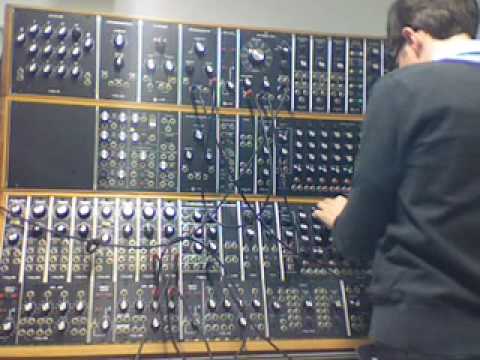
Specifications
Websites of Interest
Resources
Images from Kevin Lightner's Synthfool, Moog Archives, Moog System 55 Pictures and scans from Moog Product Brochures.
Additional information provided by DAC Crowell.
Review updated June 2012.




